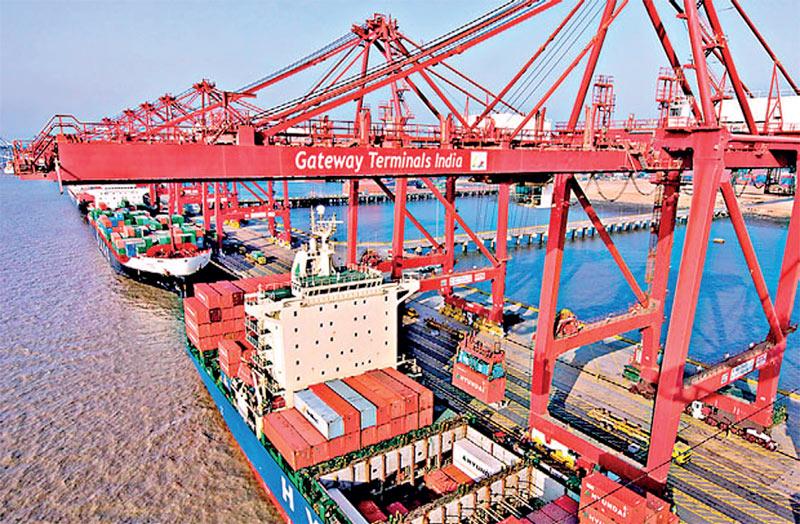13 Dec 2021 - {{hitsCtrl.values.hits}}

 Compared to other regional counterparts, Sri Lankan export performance has been declining and it can be concluded that the investments made in infrastructure projects are giving diminishing returns Compared to other regional counterparts, Sri Lankan export performance has been declining and it can be concluded that the investments made in infrastructure projects are giving diminishing returns |
 This article makes an attempt to present few socio-economic factors & indicators reflecting Sri Lankan economic downfall and examine whether it has some bearing on our failure to address serious structural weaknesses in the economy for the last 45 years.
This article makes an attempt to present few socio-economic factors & indicators reflecting Sri Lankan economic downfall and examine whether it has some bearing on our failure to address serious structural weaknesses in the economy for the last 45 years.
My view is it’s not the open economic policy that has contributed to the downfall of our economy.
It’s due to the fact that successive governments have failed in undertaking much needed structural reforms in the economy. As a result, our export performance has drastically declined and thus widening the trade deficit. It should be clearly understood that large fiscal (government budget) and external ‘current account’ deficits, popularly known as the ‘twin deficit’, are the two key structural problems in Sri Lanka identified as core weaknesses of the economy for many decades. In addition, the socio-political issues also would have contributed to the deterioration of the quality of life of the majority of people and thus eroding ‘rich value systems’ prevailed in the Sri Lankan society for a long period of time.
Socio-political issues:
The political analysts had been critically commenting on the manner in which President JRJ managed the country’s political system and governed the country during the initial period of the Presidential system under 78 Constitution. His governance style had created some kind of impression that JRJ government had made attempts to use tactics to undemocratically oppress the legitimate opposition by, first taking out the civic rights of the Leader of Opposition, Sirima Bandaranaike and the trade union instigated general strike in 1980 and then postpone the Parliamentary elections by six years through a referendum, thus playing into extreme terrorism of LTTE, JVP and breakdown in law & order.
As a result, there has been a gradual deterioration of the economy of this country, although, both President JRJ and later President Premadasa were able to transform the socio-political system in the country and spur economic growth paving way for employment creation through private investments. Since 1978, the government of the day has been following an aggressive open economic policy framework and until 2014 there has been some progress in much needed infrastructure development with the participation of foreign and local enterprises in the private sector. However, no attempt has been made to evaluate the efficacy & effectiveness of such investments to the economy. Even after the war was successfully ended by 2009, we couldn’t establish trust & understanding among communities to establish a long- lasting peace and sound national security and defence system and political stability which are necessary pre-requisites for economic development on a sustainable basis.
Examine few key economic indicators:
Government debt and depreciation of rupee:
Our total government debt was only Rs. 80 billion by end 1982, which includes some of the foreign loans obtained for the acceleration of Mahaweli development programme completed within six years.
As for rupee depreciation- by end 1977, it was Rs 15.56, and by end 1982, it was Rs 21.32 for one US$. As can be seen, it was a gradual upward movement of the value of US$ and not very high rupee depreciation during the period-1977 to 1982. Since then, government debt had been increasing at a much faster rate and at the end 2014, it has gone up to Rs. 7, 486 billion, and by end 2019, it has further increased up to Rs. 13,031 billion. Our total external debt as a percentage of GDP by end 2010 was only 38 percent and it had increased to 67 percent by end 2019. As for rupee depreciation- by end 2004, it was Rs. 104.61 for one US$ and by end 2014 it was Rs. 131.05, now it’s Rs. 204 but in the black market, it’s around Rs235-Rs. 240.
Poor export performance:
Compared to other regional counterparts, Sri Lankan export performance has been declining and it can be concluded that the investments made in infrastructure projects are giving diminishing returns.
During the two decades in 1980’s and 90’s, we saw our export performance commencing from 1980 at one billion US$ (in the year 1980) going up to US$ 4.6 billion in the year 1999 and US $ 11.9 billion in 2019.
The export performance reflects 26 percent of the GDP during the two decades ending 1999. However, the next two decades commencing 2000 to end 2019, the export performance of Sri Lanka has drastically declined to 16% of the corresponding GDP figures.
As can be seen, our trade deficit during the period 2010 to ‘19 has widened to 78 percent of total exports and our exports as a % of GDP has also decreased from 28 percent during the period 1990-99 to 14 percent during the ‘10 years period’ of 2010 to ‘19.
In fact, it was an average of only 13 percent during the period 2015 to ‘19. The export revenue has been stagnating at an average of US$ 10. 9 billion and the trade deficit has widened to an average of US$ 8.5 billion during the period 2010 to ‘19. Repeated attempts to offset the trade deficit through tourism proceeds and remittances have not been successful without having corresponding forex inflows from export proceeds and FDI. Further, the exchange rate policy has created competitiveness issues for exporters, as external trade counterparts have become more competitive at the global market place due to their currencies are getting depreciated at a faster rate.
Just to give an illustration, one cannot hold by his two hands four rubber ball in the water simultaneously for a long period of time; similarly, (i) our bank interest rates, (ii) inflation rate, (iii) rupee exchange rate and (iv) expecting large inflows of FDIs, cannot be held back for a long period of time – it’s a recipe for disaster in economic sense. These factors have adversely contributed to current macro- economic situation lowering the economic growth and development of the country.
From the above economic indicators, it can be seen that during the last seven years, the economic situation got badly affected, out of which during the last two years, it was mainly due to Covid-19 and the year-2019, it was partly due to Easter Sunday attack.
Up to now, our economy would have lost nearly US$ 10 billion as opportunity cost on account of tourism proceeds from May 2019 to end November 2021. It is expected that tourist arrivals will pick it up, targeting some 100,000 arrivals per month for the next 12 months ending 2022. It’s unfortunate the ‘political party blame culture’ also contributed to the deterioration of society’s values. Because of these events, the international community lost confidence in supporting SL and even private sector FDIs have failed to come. One can also conclude that inward looking policies will not offer solutions to foreign exchange crisis, although there is nothing wrong in promoting domestic production, smart agriculture and industrial revolutions, which covers ICT development.
We cannot find solutions by simply blaming the present government or previous governments, instead the key opinion leaders (KOLs) could get the government of the day to bring in much needed financial discipline through government budgetary process and instil new political culture and demand the government to bring in much needed structural reforms in order to reverse the declining trend.
Radical changes are needed to address structural weaknesses:
During the Presidential elections in November ‘19, a massive mandate was given by masses to the incumbent President, GR to undertake much needed ‘system change’. The economic situation would improve, if we are able to make some structural reforms in the economic front and undertake radical changes in the socio-political front which include changes to some areas of the foreign policy implementation.
The solution lies with the Government taking some bold decisions - however they need to be mindful to the political realities and maintain policy consistency, until we are able to overcome difficulties and improve credit rating.
Key structural reforms and radical changes:
a. The present US$ crisis needs to be resolved immediately.
b. Under a revolutionary Land reforms and proper land use plan, we need to identify uncultivated land parcels, which includes Mahaweli land to fast track cultivation and development work which could be handled under PPP models by inviting private sector participation with proper monitoring of progress through an effective regulatory mechanism.
c. Use ‘National Sustainable Development Council of Sri Lanka’ as the institutional vehicle to drive green economic policy changes, whilst the Council continues to focus on 17 SDGs.
d. Existing guarantees given by Multilateral agencies for some credit lines may not be available for fuel, diesel, petrol, but only for renewable energy sources. Therefore, if we continue to have diesel plants, sourcing foreign exchange without such credit lines, that becomes a serious issue, that’s why it is necessary to focus more on renewable energy.
e. Structuring mega projects have to be in line with international trends i.e.; Sustainable development goals, COP 26 Glasgow- ‘Climate change’ to attract the right investors for our projects. Indirect costs in delaying our mega projects. Colombo East Terminal (ECT), 300MW convertible power plants, Northern/Central Highway, Port access road etc. are examples resulting from delays. However, there should be a mechanism to ascertain whether the investments made in infrastructure projects are yielding desired, expected returns.
f. Drive against drugs & underworld operations, action against corrupt practices and improve public sector service efficiency. Maintain government fiscal deficit around 7% by increasing direct taxes and restructuring SOEs, thus further reducing burden of high expenditure.
g. Focus on FDI led ‘export oriented’ growth strategy coupled with increase in domestic production, light industries, SMEs, ICT applications. I.e.;GramaNiladhari tabs etc. and a mechanism to reduce cost of living rise, provide relief packages, and paddy/rice value chain.
h. Within the framework of non- aligned movement, Sri Lanka could slowly shift our foreign relations towards India Japan and the US. This would enable FDIs and bi lateral funds to flow in from these countries including UAE, South Korea, Vietnam to attract funds and resolve US sanctions imposed through western banks. Even the IMF will facilitate structural adjustments and rating will improve.
Therefore, it is suggested the government to appoint an ‘Expert Council’ to look into these areas mandating them to recommend a short- term solution within a set of ‘medium term’ strategic plans for the next three -five years.
(The writer is the Chairman of Sri Lanka Tea Board)
17 Nov 2024 29 minute ago
16 Nov 2024 6 hours ago
16 Nov 2024 6 hours ago
16 Nov 2024 7 hours ago
16 Nov 2024 7 hours ago